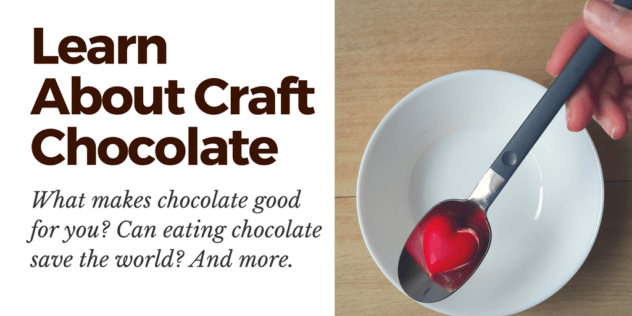When I tell people that I make chocolate at home, most of them say "oh, that's nice; must be fun" and then shrug it off & move on. They don't get it.
Maybe they don't know how chocolate is made, or assume that I mean chocolate cakes and cookies. That's fine. But I like to go deeper into it, if I can spend more than a minute with someone (because once you get me onto the subject of chocolate, it's hard to get me off it).
A superficial discussion of chocolate strikes me as an oxymoron, and simply impossible if I'm at either end of the discussion. So this page is for you, my beloved craft chocolate makers.
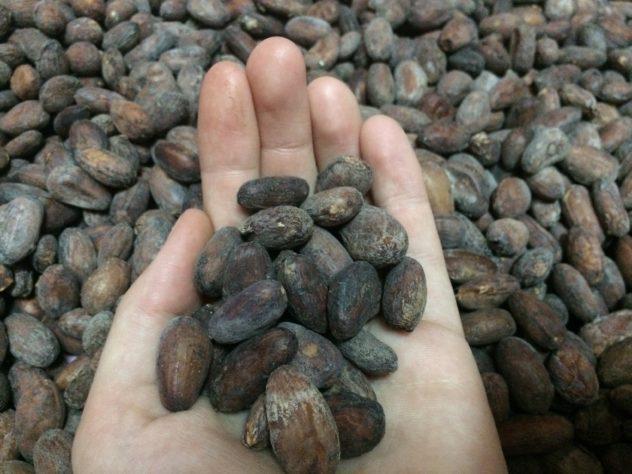
Whether you're a home hobbyist or starting up your value-added chocolate company, or you've been in the micro-batch game for decades, this page is for you. Dedicated to all things chocolate making, below you'll find resources to improve your knowledge of our shared passion.
If you want to learn more about chocolate, might I suggest reading all about the origins of white chocolate and how ruby chocolate was invented. From there, learn about chocolate expiration dates and what makes chocolate good for you. For even more reading, discover a favorite book about chocolate!
Feel free to explore the site at your leisure, and reach out to me on social media or through my about page or by leaving a comment on a post. I don't have all the answers, but I probably do have all the chocolate.
Click one of the images below to read more.
Social Media for Chocolate Makers
First, learn the absolute basics
and get started with Instagram.
Then learn how to improve your Instagram content,
and while you're at it, learn how to build an audience
before making more effective ads.
I'll wait.
Okay, now that you have a solid base understanding of what social media is and why it's important for building your chocolate business, it's time to put these into practice. Open accounts on various social media, and at the very least make sure you have the name of your business under your control. If someone else opens an account pretending to be you, that could hurt your business. Make sure your name is protected.
Next, build up your profiles following the basic tips from above, and give your networks some of your own personality. Though maybe leave the selfies for your personal profile, unless they're showcasing your chocolate journey!
Social Media: Further Reading
- Crafting a Killer Instagram Bio
- Instagram Marketing for Restaurants or Cafes
- Facebook Post Ideas
- Boost Facebook Engagement
- Twitter Tips for Lost Beginners
- Learn From Successful Food Businesses on Twitter
- Branding Your Business on Pinterest
- Pinterest for Small Businesses
Whether you're a new or experienced business owner, your social media could always use a boost! Just keep testing and see what your audience likes.

Lifelong Learning
As a chocolate maker, you should invest a few hours a week (or a day) into learning more about this ever-growing industry. You cannot become an expert in everything, but it never hurts to try! To get your creative juices flowing, here are some of the best sources for improving your ability to source cacao, troubleshoot chocolate making, stay up to date on the industry, and much more. It's true that the best way to improve is to practice, practice, practice & repeat.
Sometimes this involves eating lots of chocolate, but hey, someone's gotta do the heavy lifting (all the way to your mouth).
Best Books for Learning Chocolate History
Undeniably, you must start with Maricel Presilla's book The New Taste of Chocolate, Revised: A Cultural & Natural History of Cacao with Recipes. Presilla is a well-deserved celebrity in the chocolate world, known for her many books on chocolate and Latin American culinary culture. But this exploration of the cacao plant and its storied past is perfect for building a basic chocolate knowledge.
Continue with a different perspective on The True History of Chocolate, from Sophie & Michael Coe. In this third edition of the book, the couple overviews chocolate's journey into the beloved sweet of today through its humble beginnings on the American continent. Be warned, not all was as we might have expected it to have been.
Best Books for Learning Chocolate Making
Dandelion Chocolate's Making Chocolate: From Bean to Bar to S'more has quickly risen in the ranks as a go-to book for burgeoning chocolate makers around the world. In vivid detail and with beautiful accompanying images, the book contributes insight into a chocolate maker's journey, building up a factory, sourcing materials, and finding their footing.
Megan Giller's Bean-to-Bar Chocolate: America’s Craft Chocolate Revolution: The Origins, the Makers, and the Mind-Blowing Flavors. This book is part novel, part chocolate resource book, adding to the history of cacao by exploring the history of fine chocolate in the movement's birthplace of The US. Going over the movement's key players and defining moments, Giller's book has quickly become a cornerstone of the craft chocolate lover's bookshelf.

Best Books for Learning Chocolate Tasting & Pairing
Chloe Doutre-Roussel's The Chocolate Connoisseur: For Everyone With a Passion for Chocolate. This is one of the oldest and most established books on chocolate, and it's in no way lost its relevance. Chloe has become legendary in the fine chocolate world for her breadth of knowledge about cacao & chocolate, and her many contributions to the industry's growth.
Be sure to pair this with a look at my Chocolate Tasting Resource.
Chocolate Podcasts
Max Gandy, Chocolate On The Road: hosted by myself (Max Gandy), COTR is the auditory equivalent to this very blog. Each month the show explores a hot topic or destination for chocolate, weaving together history, culture, and lived experiences to make a storytelling podcast that’s part interview and part documentary.
Rather than straight discussions with chocolate industry people around the world, the show pulls together a whole other story from the narratives, bringing something heretofore unheard of in the world of chocolate. Currently on a long hiatus.
David Nilsen, Bean To Barstool: the newest addition to the chocolate podcast repertoire is certified ciserone David Nilsen's beer & chocolate podcast. A couple times a month, David dives into a specific aspect or intersection of craft beer and craft chocolate, talking to experts in both industries about their experiences therein.
In his own words, "Bean to Barstool is about a deeper experience of tasting craft beer & bean to bar chocolate, and what that experience can tell us about ourselves."
Simran Sethi, The Slow Melt: the first season features surface-skimming reports on various aspects of the chocolate industry, from the history of craft chocolate and cacao origins to how to best savor chocolate. During the second season, Simran focuses on interviews with established chocolate makers around the world. Currently on a long hiatus.
Sunita De Tourreil & Brian Beyke, Unwrapped: as a foremost chocolate thought leader and pioneer in the craft chocolate movement, Sunita pairs with Brian (coffee expert extraordinaire) to bring you bi-monthly forays into the craft chocolate community. Currently on a long hiatus.
Brian Ruggles, Chocolate Fascination: after over a decade as president and founder of the Chocolate Society of Utah, Brian has taken his love of bean to bar chocolate to the podcast realm. In his weekly interview show he's bringing chocolate movers & shakers from Utah chocolate and beyond into the public eye. Currently on hiatus.
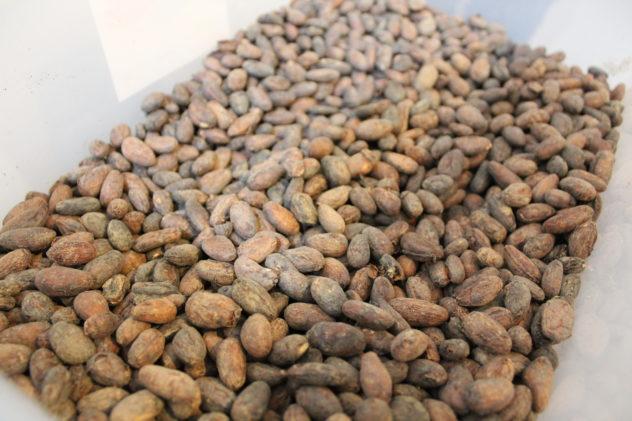
Bean to Bar Experiments
As a chocolate making hobbyist, quality ingredients matter to me as much if not more than the final flavor. So I always source my cacao from people & places I trust. Living abroad, I came to know my local cocoa importers, but if I lived in North America or Europe I would head to Chocolate Alchemy.
I had friends bring me cocoa butter from the States, and I could buy sugar in Korea. My machine was purchased through an importer there, and my molds were bought at the crafts store in my town. A little creativity could build up your own home chocolate factory (though mine has since disbanded, due to my travel plans!).
Timeline: 2015 brought a lot of trial and error with learning how to use my Premiere Wonder Grinder to make chocolate in Ecuador. Then, around New Year's 2016 I was experimenting with different milk powders while making my first chocolate in the US. During 2017, while living in South Korea, I made bean to bar chocolate in Korea for the first time.
Then I tried my hand at a dark chocolate with Vietnamese cacao, white chocolate making + waaaaay too much salt, and becoming a certified chocolate maker with Ecole Chocolat. 2018 & 2019 brought my podcast and a lot of growth to this site, and therefore, no home chocolate making experiments. Honestly, I'm not expecting much home chocolate making in the 2020's either, as plans for expansion (& covid) continue, but I hope you find my past experiments helpful!
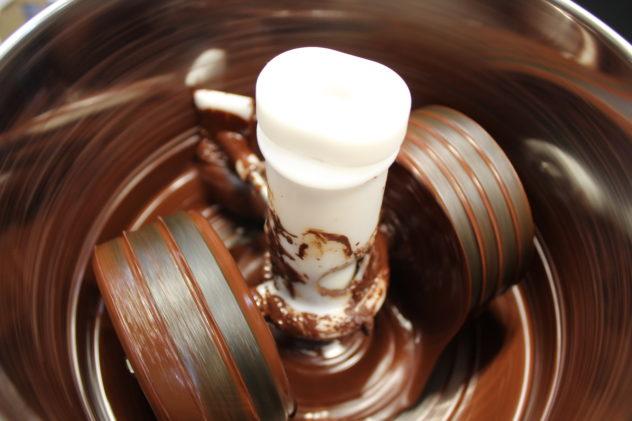
Where to Buy...
When making chocolate, not all ingredients are equal. Depending on where you live, however, not all chocolate making ingredients are easily accessible. This means that most makers need to purchase materials online, especially true as their businesses and/or hobbies grow.
People will want to taste your chocolate, whether it's "good enough" yet, or not. So make enough for a crowd! Recommendations for where to buy cocoa nibs, whole cacao beans, milk powders, sugars, lecithins, and cocoa butter for chocolate making are congregated below.
Cacao Nibs & Beans
The cocoa bean market has blossomed over the last ten years or so, going from sourcing adventure to online market place in less than a decade. Many cacao cooperatives are selling their own beans directly to makers, though there are a number of aggregator sites you may want to work with when you're first starting out.
My go-to would have been Chocolate Alchemy, if I hadn't already had a local cacao seller in Korea. John's been top in the market for years now, and has some of the widest & highest-quality selection availble.
Other notable cacao sources are Uncommon Cacao in Latin America, Ucayali River Cacao in Peru, Kokoa Kamili in Tanzania, and Cacao Fiji in Fiji. There are many more, but you can find a more comprehensive list on here.
Cocoa Butter
My first piece of advice is to be careful. Not all cocoa butters are created equal. There are two basic kinds of cocoa butter: deodorized and natural. A deodorized cocoa butter has been heated or chemically treated, and the aromas forcibly removed. A natural cocoa butter has been pressed directly from cacao beans (either raw or roasted), and sold in that state. But cocoa butter is also used for cosmetics, so when buying cocoa butter, you need to make sure that the product is labeled as food safe.
The machinery used to remove cocoa butter (the fat of the cacao seeds) from the seeds is still rather expensive, so there are many fewer cocoa butter sellers than chocolate sellers. If you're just starting out, check out Amazon for the best prices on small amounts of cocoa butter. My recommendations are this 1-pound bag from Divine Organics or this 1 pound of Organic Cacao Butter from Terrasoul.
Milk Powders
In line with the cocoa butter quality difference, milk powders are not only varying in quality, but also characteristics. For example, protein and fat content in a skim milk powder versus a goat's milk powder are completely different. Add in other fat possibilities such as coconut or soy milk powders, and there are too many options to count.
My suggestion is to first check Vitacost for reasonable prices and smaller quantities with a wide selection. For those outside of the US, check a local health food store, as many suitable milk powders and milk powder alternatives are easily available these days. Just remember: never add any liquids to chocolate except for cocoa butter (which doesn't count since it's liquid fat, not water-based).
Sugars
Would you be surprised if I told you that not all sugars are created equal, either? By now, I hope you're expecting this truth bomb, because as I've said, chocolate making is complicated. Once you get a handle on it, it's also fascinating, but even just looking at the types of sugar on the market can overwhelm the best of us.
Since so many plants produce sugar to store energy, there are dozens of possibilities of sweeteners. These range from the traditional cane sugar to monkfruit and xylitol options. Again, I'd recommend Vitacost for a variety of sugars to play around with at a low cost and in smaller amounts.
Lecithins
I am by no means a be-all end-all source for lecithins. In fact, I've never used them in my own chocolates. But there are some makers who like to change up their recipes and dabble with lecithin. If you'd like to experiment, first you need to know what lecithin is. The basic idea is that lecithin is a fat which makes your chocolate less thick, reducing or eliminating the need for added cocoa butter.
Here you can read a more in-depth article on lecithins. Lecithins of any kind are harder to get your hands on then the other ingredients in chocolate, though specialty chocolate sites often have a few to choose from.
Inclusions
Often the last ingredient chocolate makers add to their creations, inclusions can be confusing. They're basically any ingredient added to chocolate beyond the basics, though chemical preservatives and artificial flavors don't count.
"Inclusion" is a general term, but the basic definition is an addition. A bar with inclusions could feature anything from candied violet or whole coffee beans to pink sea salt.
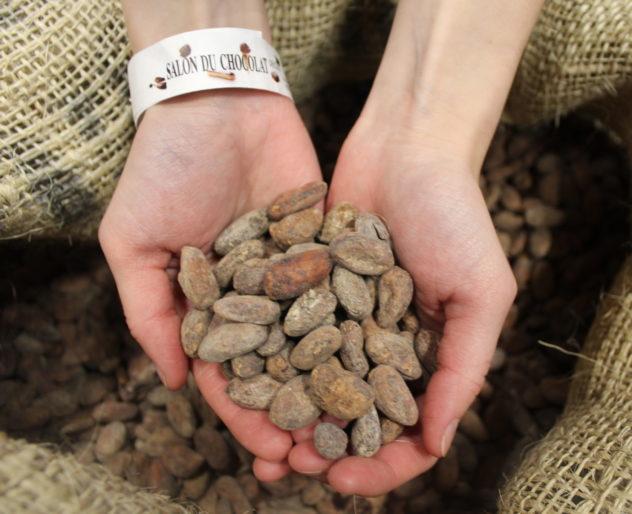
Craft Chocolate Reviewers
- Trish, My Year in Chocolate
- Evelyn, Distinguished Beans
- Mae, Bean Blah Blah
- Barbie, Finding Fine Chocolate
- Mark, C-Spot

